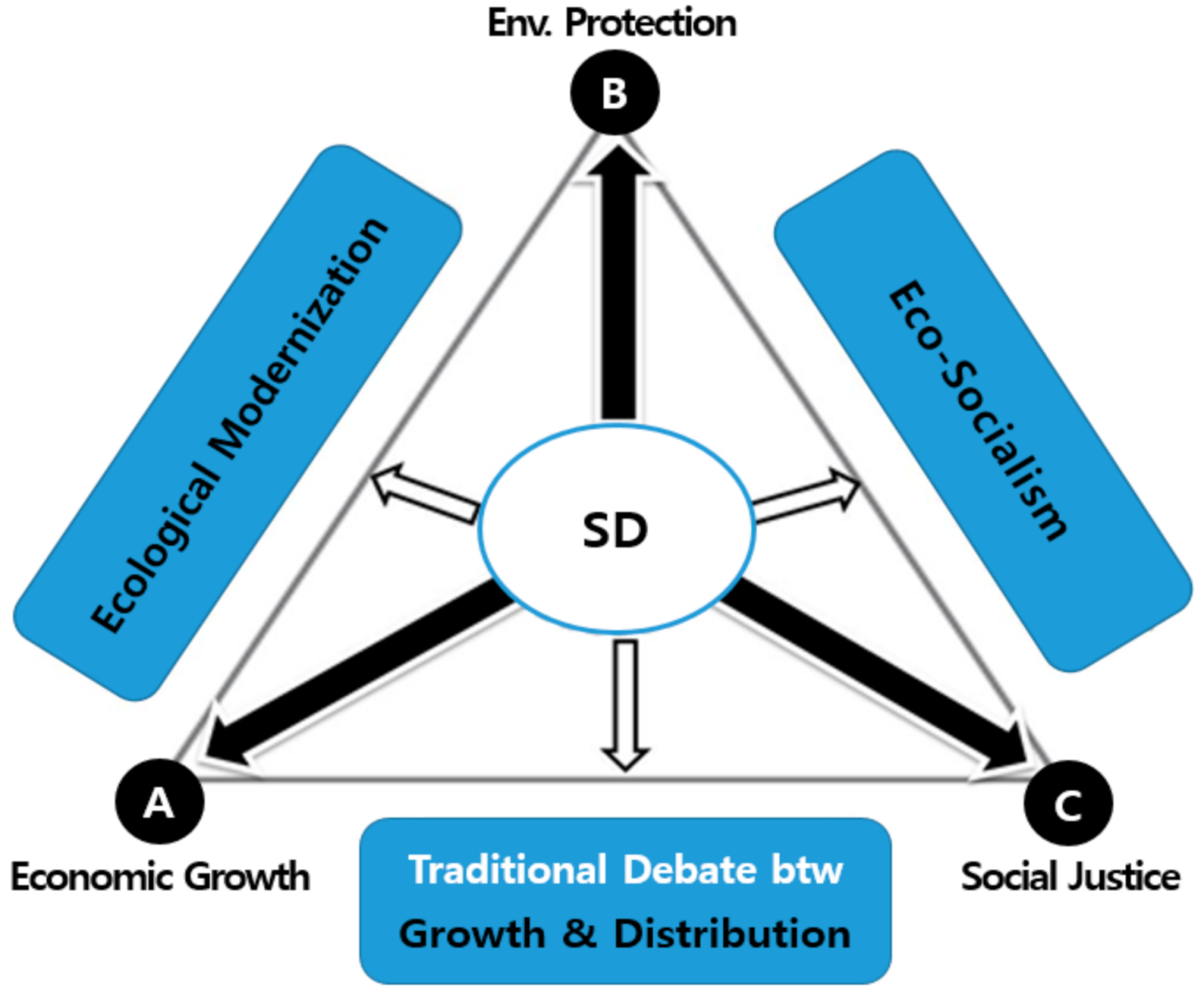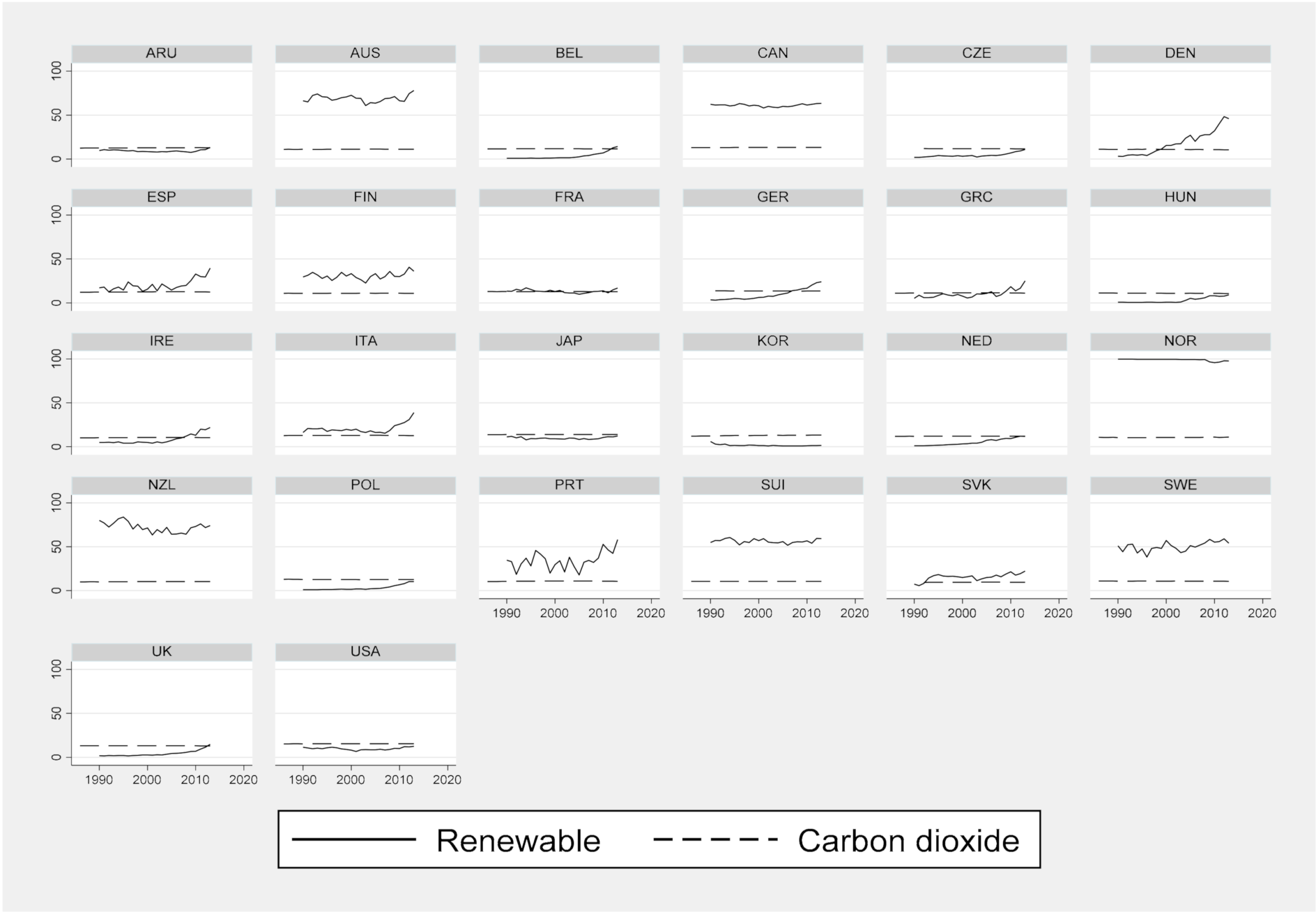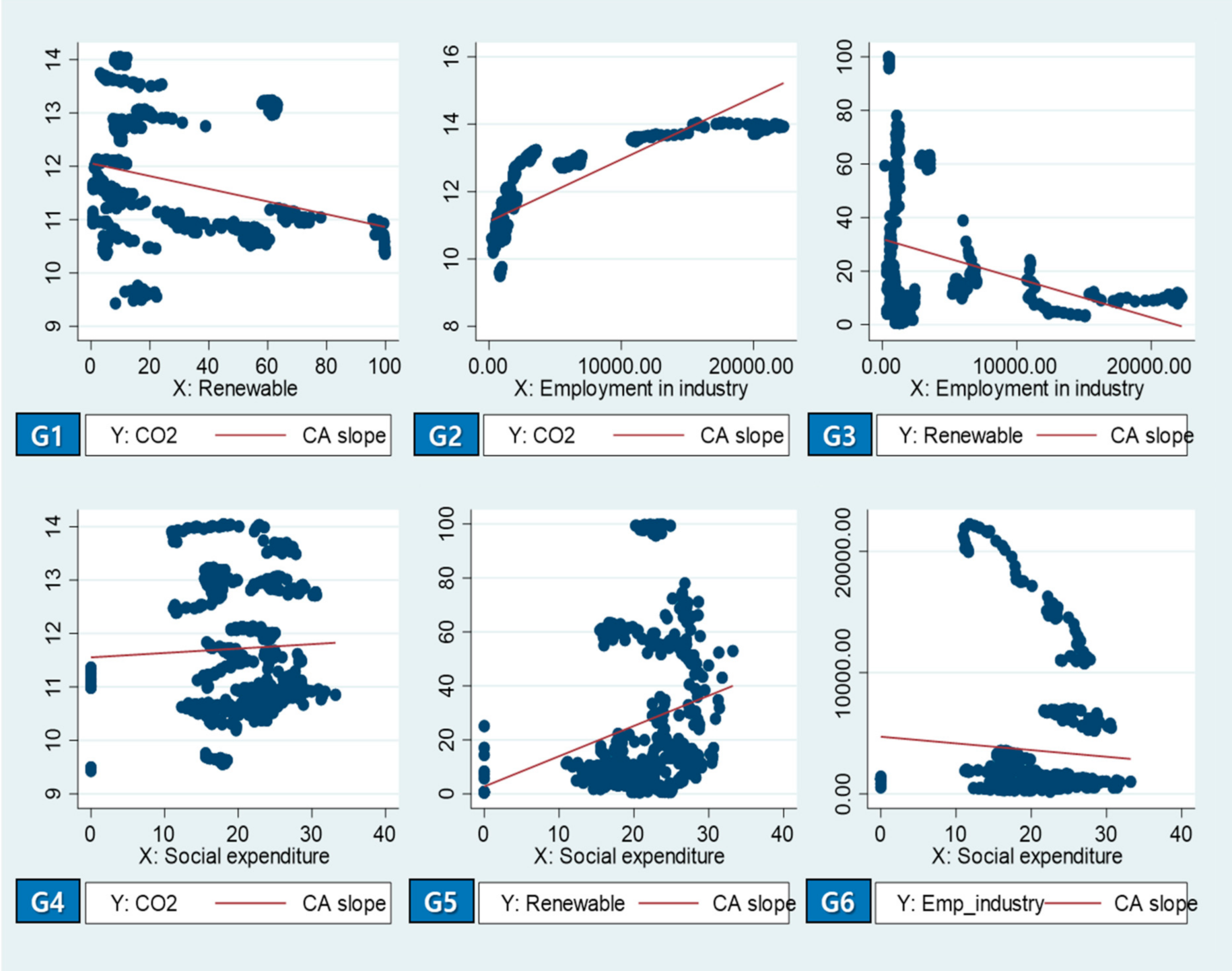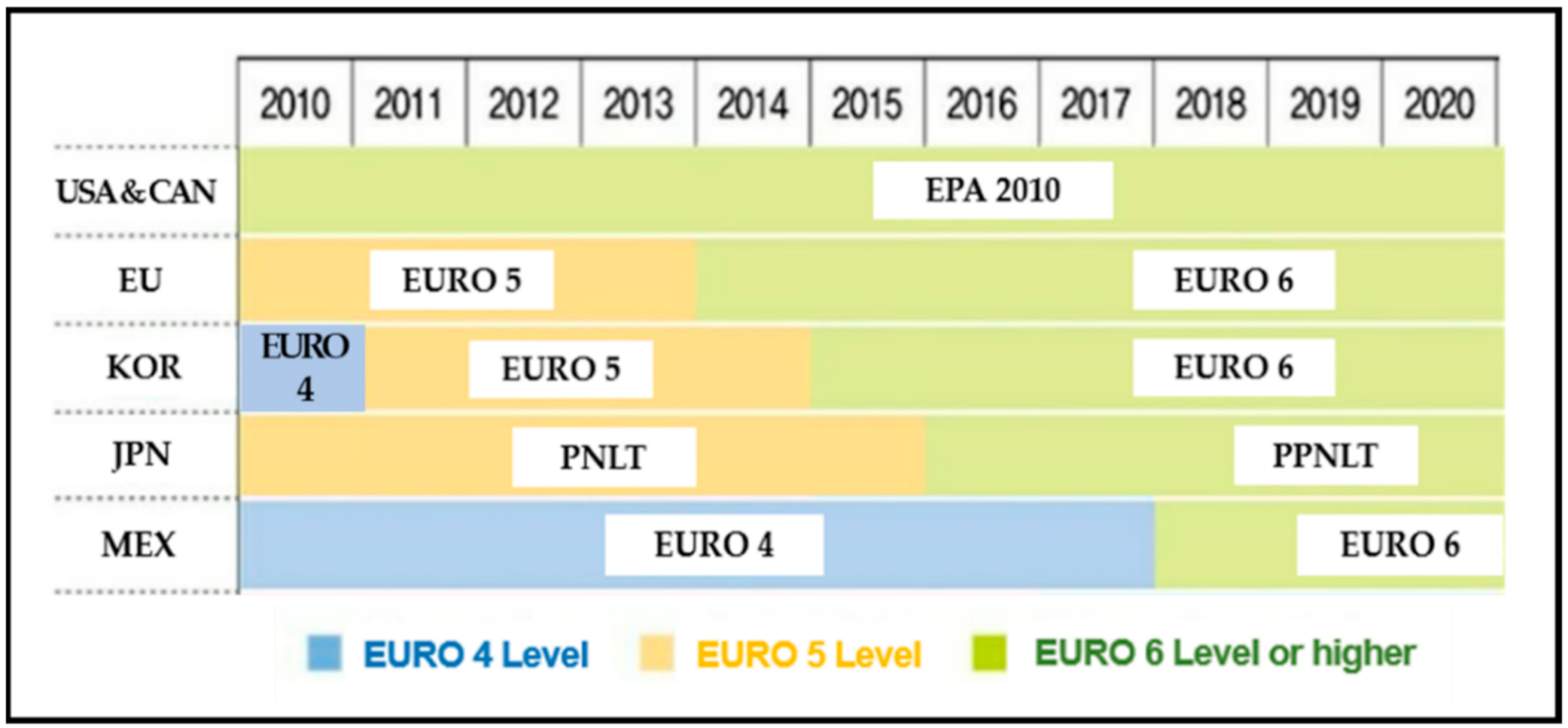Triangular Trajectory of Sustainable Development: Panel Analysis of the OECD Countries
Abstract
1. Introduction
- How has the relationship among the three pillars of SD (economic–social–environment sectors) in the OECD countries changed since SD officially appeared in the World Conference on Environment and Development (WCED) in 1987?
- Did the economic sector positively affect the environment sector (particularly climate change) in time-series?
- Did the social sector positively affect the environment (particularly climate change) in time-series?
2. Theoretical Background and Issues
2.1. The History and Notions of Sustainable Development
2.2. Three Pillars of Sustainable Development and Eco-Socialism and Ecological Modernization
3. Methodology and Measurement Framework
3.1. Panel Data and Analysis
3.2. Measurement Framework
4. Research Findings
4.1. Analytical Results
4.2. Correlationship Analysis
5. Conclusions and Implications
Author Contributions
Funding
Institutional Review Board Statement
Informed Consent Statement
Data Availability Statement
Conflicts of Interest
References
- Lafferty, W.M. Introduction: Form and function in governance for sustainable development. In Governance for Sustainable Development: The Challenge of Adapting form to Function; Lafferty, W.M., Ed.; Edward Elgar Publishing Limited: Cheltenham, UK, 2004. [Google Scholar]
- Lafferty, W.M.; Meadowcroft, J. (Eds.) Implementing Sustainable Development; Oxford University Press: Oxford, UK, 2000. [Google Scholar]
- O’Riordan, T. (Ed.) Transition to Sustainability: The Politics of Agenda 21 in Europe; Earthscan: London, UK, 1998. [Google Scholar]
- WCED. Our Common Future; Oxford University Press: Oxford, UK, 1987. [Google Scholar]
- Rieu-clake, versionA. An Overview of Stakeholder Participation within the Danube Basin: What Current Practice and Future Challenges? In Stakeholder Participation in Transboundary Water Management—Selected Case Studies; Earle, A., Malzbender, D., Eds.; African Centre for Water Research: Cape Town, South Africa, 2006. [Google Scholar]
- UN. Transforming Our World: The 2030 Agenda for Sustainable Development; United Nations: New York, NY, USA, 2015. [Google Scholar]
- Jordan, A. The governance of sustainable development: Taking stock and looking forwards. Environ. Plan. C Gov. Policy 2008, 26, 17–33. [Google Scholar] [CrossRef]
- UNFCCC. Aggregate Effect of the Intended Nationally Determined Contributions: An Update; UNFCCC: New York, NY, USA, 2016. [Google Scholar]
- KPMG. Future State 2030: The Global Megatrends Shaping Governments; KPMG International Cooperative: Amstelveen, The Netherlands, 2014. [Google Scholar]
- Palanichamy, C.; Naveen, P.; Muthusundar, S.K. A sustainable renewable energy mix option for the secluded society. J. Renew. Sustain. Energy 2014, 6, 023124. [Google Scholar] [CrossRef]
- Roorda, C.; Wittmayer, J. Transition Management in Five European Cities—An Evaluation; DRIFT: Rotterdam, The Netherlands, 2014. [Google Scholar]
- REN21. Global Status Report. In Renewable Energy Policy Network for the 21st Century; REN21: Paris, France, 2015. [Google Scholar]
- Samjong KPMG Economic Research Institute (ERI). 2018 Major Issues and Issues in the Energy Sector; ERI: Seoul, Korea, 2018. [Google Scholar]
- Mebratu, D. Sustainability and sustainable development: Historical and conceptual review. Environ. Impact Assess. Rev. 1998, 18, 493–520. [Google Scholar] [CrossRef]
- Robinson, J. Squaring the circle? Some thoughts on the idea of sustainable development. Ecol. Econ. 2004, 48, 369–384. [Google Scholar] [CrossRef]
- Kemp, R.; Parto, S.; Gibson, R.B. Governance for sustainable development: Moving from theory to practice. Intl. J. Sustain. Dev. 2005, 8, 12–30. [Google Scholar] [CrossRef]
- Lee, J.H. The Nonlinearity between Global Climate Change and Democracy: Evidence from Panel Data for 170 Countries. Korean Assoc. Int. Stud. 2019, 59, 199–228. [Google Scholar]
- Jang, W.S. Climate Change and the Model of Democracy. J. Env. Policy Adm. 2016, 24, 85–107. [Google Scholar] [CrossRef]
- Zeijl-Rozema, A.; Cörvers, R.; Kemp, R.; Martens, P. Governance for sustainable development: A framework. Sustain. Dev. 2008, 16, 410–421. [Google Scholar] [CrossRef]
- Bookchin, M. Defending the Earth; South End Press: Boston, MA, USA, 1991. [Google Scholar]
- Savitch, H.V. Global challenge and institutional capacity: Or how we can refit local administration for the next century. Adm. Soc. 1998, 30, 248–273. [Google Scholar] [CrossRef]
- Bell, S.; Morse, S. Delivering sustainability therapy in sustainable development projects. J. Environ. Manag. 2005, 75, 37–51. [Google Scholar] [CrossRef]
- KCLA 21. A Final Report on the Building Plan of Environmental Governance for Sustainable Local Development; Ministry of Environment: Sejong, Korea, 2004. [Google Scholar]
- Weale, A. Governance, government, and the pursuit of sustainability. In Governing Sustainability; Adger, N., Jordan, A., Eds.; Cambridge University Press: Cambridge, UK, 2009. [Google Scholar]
- White, L.G. Policy Analysis as Discourse. J. Policy Anal. Manag. 1994, 13, 506–525. [Google Scholar] [CrossRef]
- Connelly, S. Mapping sustainable development as a contested concept. Local Environ. 2007, 12, 259–278. [Google Scholar] [CrossRef]
- Yoon, S.J. The Ideological Basis and the Reality of ‘Low Carbon Green Growth’. ECO 2009, 13, 219–266. [Google Scholar]
- Dryzek, J. The Politics of the Earth: Environmental Discourses, 3rd; Oxford University Press: Oxford, UK, 2013. [Google Scholar]
- Korea Economic Research Institute. Trends and Implications of Deregulation of Greenhouse Gas Emissions and Economic Growth in Major Countries; KERI: Ulsan, Korea, 2017. [Google Scholar]
- Eckersley, R. The Green State—Rethinking Democracy and Sovereignty; MIT Press: Cambridge, MA, USA, 2004. [Google Scholar]
- Buttel, F.H. Ecological Modernization as Social Theory. Geoforum 2000, 31, 57–65. [Google Scholar] [CrossRef]
- Sondergard, B. Ecological modernisation and institutional transformations in the Danish textile industry. J. Clean. Prod. 2004, 12, 337–352. [Google Scholar] [CrossRef]
- Huber, J. Die Regenbogengesellschaft. Ökologie und Sozialpolitik; Fisher Verlag: Frankfurt am Main, Germany, 1985. [Google Scholar]
- Huber, J. Towards industrial ecology: Sustainable development as a concept of ecological modernization. J. Environ. Policy Plan. 2000, 2, 269–285. [Google Scholar] [CrossRef]
- Hajer, M.A. Ecological Modernization as Cultural Politics in S. Lash and B. Szerszynski, Risk. In Environment, and Modernity; Sage Publisher: London, UK, 1996. [Google Scholar]
- Adams, W.M. Green Development, 2nd ed.; Routledge: London, UK, 2001. [Google Scholar]
- Meadowcroft, J. From Welfare State to Environmental State. J. Eur. Soc. Policy 2008, 18, 325–344. [Google Scholar]
- Bailey, D. The Environmental Paradox of the Welfare State: The Dynamics of Sustainability. New Political Econ. 2015, 20, 793–811. [Google Scholar] [CrossRef]
- Gough, I. Welfare states and environmental states: A comparative analysis. Environ. Politics 2016, 25, 24–47. [Google Scholar] [CrossRef]
- Baltagi, B. Econometric Analysis of Panel Data, 4th ed.; John Wiley & Sons: Hoboken, NJ, USA, 2008. [Google Scholar]
- Beck, N.; Katz, J.N. What to do (and not to do) with time-series cross-section data. Am. Political Sci. Rev. 1995, 89, 634–647. [Google Scholar] [CrossRef]
- Jänicke, M. The Political System’s Capacity for Environmental Policy: The Framework for Comparison. In Capacity Building in National Environmental Policy; Weidner, H., Jänicke, M., Eds.; Springer: Berlin, Germany, 2002. [Google Scholar]
- IPCC. Summary for Policymakers in Climate Change 2014 Mitigation of Climate Change; Cambridge University Press: Cambridge, UK, 2014. [Google Scholar]
- Marques, A.C.; Fuinhas, J.A. Drivers Promoting Renewable Energy: A Dynamic Panel Approach. Renew. Sustain. Energy Rev. 2008, 15, 1601–1608. [Google Scholar] [CrossRef]
- Davidson, K. A Typology to Categorize the Ideologies for Actors in the Sustainable Development Debate. Sustain. Dev. 2014, 22, 1–14. [Google Scholar] [CrossRef]
- Domac, J.; Richards, K.; Risovic, S. Socio-economic Drivers in Implementing Bioenergy Projects. Biomass Bioenergy 2008, 28, 97–106. [Google Scholar] [CrossRef]
- McKay, H. Environmental, Economic, Social and Political Drivers for Increasing Use of Wood fuel as a Renewable Resource in Britain. Biomass Bioenergy 2006, 30, 308–315. [Google Scholar] [CrossRef]
- Torvanger, A. Manufacturing Sector Carbon Dioxide Emissions in Nine OECD Countries, 1973–1987. Energy Econ. 1991, 13, 168–186. [Google Scholar] [CrossRef]
- Greening, L.A. Effects of Human Behavior on Aggregate Carbon Intensity of Personal Transportation: Comparison of 10 OECD Countries for the Period 1970–1993. Energy Econ. 2004, 26, 1–30. [Google Scholar] [CrossRef]
- Timilsina, G.R.; Shrestha, A. Transport Sector CO2 Emissions Growth in Asia: Underlying Factors and Policy Options. Energy Policy 2009, 37, 4523–4539. [Google Scholar] [CrossRef]
- Kim, Y.; Cho, J. Does social protection crowd out social investment? Policy Soc. 2020, 39, 208–225. [Google Scholar] [CrossRef]
- Videras, J. Exploring spatial patterns of carbon emissions in the USA: A geographically weighted regression approach. Popul. Environ. 2014, 36, 137–154. [Google Scholar] [CrossRef]
- Kang, Y.Q.; Zhao, T.; Yang, Y.Y. Environmental Kuznets curve for CO2 emissions in China: A spatial panel data approach. Ecol. Indic. 2016, 63, 231–239. [Google Scholar] [CrossRef]
- World Bank. World Bank Dataset 2020, CO2 Emissions. Available online: https://data.worldbank.org/indicator/EN.ATM.CO2E.PC (accessed on 9 October 2020).
- World Bank. World Bank Dataset 2020, Renewable Electricity Output. Available online: https://data.worldbank.org/indicator/EG.ELC.RNEW.ZS (accessed on 9 October 2020).
- Armingeon, K.; Wenger, V.; Wiedemeier, F.; Isler, C.; Knöpfel, L.; Weisstanner, D.; Engler, S. Comparative Political Data Set 1960–2017; Institute of Political Science, University of Berne: Berne, Switzerland, 2020. [Google Scholar]
- OECD. OECD Social Expenditure Dataset 2020. Available online: https://www.oecd.org/social/expenditure.htm (accessed on 14 November 2020).
- Huh, T. Comparative and Relational Trajectory of Economic Growth and Greenhouse Gas Emission: Coupled or Decoupled? Energies 2020, 13, 2550. [Google Scholar] [CrossRef]
- US Energy Information Administration. Energy Outlook 2014; Office of Integrated and International Energy Analysis; EIA: Washington, DC, USA, 2014. [Google Scholar]
- US Energy Information Administration. Energy Outlook 2018; Office of Integrated and International Energy Analysis; EIA: Washington, DC, USA, 2018. [Google Scholar]
- Mor, S.; Jindal, S. Estimation of Environmental Kuznets Curve and Kyoto Parties: A Panel Data Analysis. Int. J. Comput. Eng. Manag. 2012, 15, 5–9. [Google Scholar]
- Friedl, B.; Getzner, M. Determinants of CO2 Emissions in a Small Open Economy. Ecol. Econ. 2003, 45, 133–148. [Google Scholar] [CrossRef]
- PBL Netherlands Environmental Assessment Agency, EC Joint Research Centre. Trends in Global CO2 Emissions: 2013 Report; Den Haag: Amsterdam, The Netherlands, 2013. [Google Scholar]
- The Office of the United States Trade Representative (USTR). FACT SHEET: WTO Environmental Goods Agreement: Promoting Made-in-America Clean Technology Exports, Green Growth and Jobs; USTR: Washington, DC, USA, 2007. [Google Scholar]
- Cosbey, A.; Tarasofsky, R. Climate Change, Competitiveness and Trade; A Chatham House Report; Chatham House: London, UK, 2007. [Google Scholar]
- World Bank. Warming Up to Trade? Harnessing International Trade to Support Climate Change Objectives; World Bank: Washington, DC, USA, 2007. [Google Scholar]
- IPCC. Climate Change 2007: IPCC Fourth Assessment Report; IPCC: Geneva, Switzerland, 2007. [Google Scholar]
- OECD. CO2 Emissions from Fuel Combustion; OECD: Paris, France, 2005. [Google Scholar]
- OECD. CO2 Emissions from Fuel Combustion; OECD: Paris, France, 2015. [Google Scholar]
- OECD. CO2 Emissions from Fuel Combustion; OECD: Paris, France, 2019. [Google Scholar]
- Lee, C.W. A Study on the Promotion of Welfare Environmental Policy in Seoul; Seoul Institute: Seoul, Korea, 2013. [Google Scholar]
- Park, S.A. Preparing a Plan to Realize Environmental Welfare; Seoul National University: Seoul, Korea, 2013. [Google Scholar]




| Categories | Operationalization | Source | ||
|---|---|---|---|---|
| Dependent Variables | Environment | CO2 emissions | CO2 emissions (metric tons per capita) 1987~2014 | World bank dataset (2020) [54] |
| Renewable electricity output | Renewable electricity output (% of total electricity output) 1987~2014 | World bank dataset (2020) [55] | ||
| Independent Variables | Economy | Real GDP | Growth of real GDP, percentage change from previous year | Armingeon et al. (2019) [56] |
| Employment in industry | Civilian employment in industry, in thousands | Armingeon et al. (2019) [56] | ||
| Globalization | Openness of the economy, measured as total trade (sum of import and export) as a percentage of GDP at current prices | Armingeon et al. (2019) [56] | ||
| Society | Social expenditure | All social expenditure per capita | OECD (2020) [57] | |
| Population | Total population, in thousands. | Armingeon et al. (2019) [56] | ||
| Left party | Government support: parliamentary seat share of social democratic and other left-leaning parties in government | Armingeon et al. (2019) [56] | ||
| Green party | Government support: parliamentary seat share of green parties in government. | Armingeon et al. (2019) [56] | ||
| CO2 | Renewable Electricity Output | Employment in Industry | ||||||
|---|---|---|---|---|---|---|---|---|
| Renewable Electricity Output | Employment in Industry | Social Expenditure | Green Party | Employment in Industry | Social Expenditure | Green Party | Social Expenditure | |
| correlation coefficient | −0.4055 *** (0.001) | 0.8412 *** (0.0000) | −0.2111 *** (0.000) | −0.071 (0.06) | −0.2905 *** (0.0000) | 0.2027 *** (0.0000) | 0.1047 (0.010) | −0.2111 *** (0.0000) |
| Dependent Variables | CO2 Emissions (log Value) | Renewable Electricity Output | |||||
|---|---|---|---|---|---|---|---|
| PCSE 1987–2013 | PCSE (1st)87–2002 | PCSE (2nd)03–13 | PCSE 1987–2013 | PCSE (1st)87–2002 | PCSE (2nd)03–13 | ||
| Economy | Real GDP | 0.005 *** | 0.001 | 0.006 *** | 0.156 * | 0.236 | 0.306 * |
| Globalization | −0.001 | 0.000 | −0.002 *** | −0.101 *** | −0.226 *** | −0.186 *** | |
| Employment in industry | 0.002 *** | 0.002 *** | 0.01 *** | 0.0001 * | 0.002 *** | 0.002 *** | |
| Society | Social expenditure | 0.001 | 0.002 | −0.017 *** | 0.264 ** | 0.353 *** | 0.575 |
| Population | 0.995 *** | 0.986 *** | 0.992 *** | −13.378 *** | −17.473 *** | −16.175 *** | |
| Green * Left party | −0.000 | −0.000 | 0.000 | 0.001 | 0.003 | −0.001 | |
| _cons | 2.453 *** | 2.507 *** | 3.068 *** | 15.062 *** | 191.464 *** | 177.630 *** | |
Publisher’s Note: MDPI stays neutral with regard to jurisdictional claims in published maps and institutional affiliations. |
© 2021 by the authors. Licensee MDPI, Basel, Switzerland. This article is an open access article distributed under the terms and conditions of the Creative Commons Attribution (CC BY) license (http://creativecommons.org/licenses/by/4.0/).
Share and Cite
Huh, T.; Kim, Y.Y. Triangular Trajectory of Sustainable Development: Panel Analysis of the OECD Countries. Int. J. Environ. Res. Public Health 2021, 18, 2374. https://doi.org/10.3390/ijerph18052374
Huh T, Kim YY. Triangular Trajectory of Sustainable Development: Panel Analysis of the OECD Countries. International Journal of Environmental Research and Public Health. 2021; 18(5):2374. https://doi.org/10.3390/ijerph18052374
Chicago/Turabian StyleHuh, Taewook, and Yun Young Kim. 2021. "Triangular Trajectory of Sustainable Development: Panel Analysis of the OECD Countries" International Journal of Environmental Research and Public Health 18, no. 5: 2374. https://doi.org/10.3390/ijerph18052374
APA StyleHuh, T., & Kim, Y. Y. (2021). Triangular Trajectory of Sustainable Development: Panel Analysis of the OECD Countries. International Journal of Environmental Research and Public Health, 18(5), 2374. https://doi.org/10.3390/ijerph18052374






